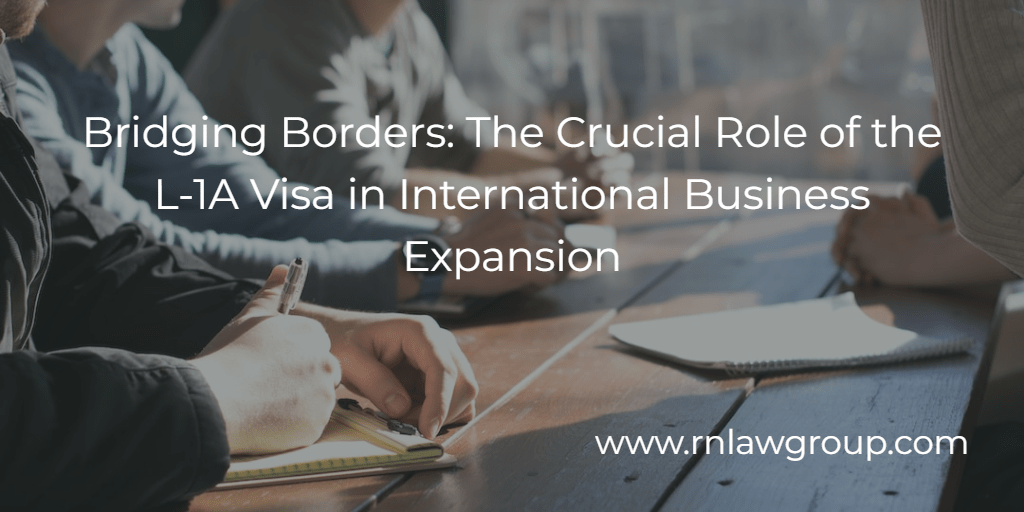
Bridging Borders: The Crucial Role of the L-1A Visa in International Business Expansion
Introduction:
In an era of globalization, businesses strive to expand their reach across borders, seeking to establish and strengthen their presence in various markets. The L-1A visa stands as a crucial instrument in achieving this goal, allowing multinational companies to transfer executives or managers from their foreign offices to the United States. This article delves into the nuances of the L-1A visa, examining its eligibility requirements, application process, and the impact it has on both employers and transferee executives.
Understanding the L-1A Visa:
The L-1A visa is a non-immigrant visa category specifically designed for executives and managers within multinational companies. Its primary purpose is to facilitate the intra-company transfer of key personnel to the United States, thereby supporting the growth and development of U.S. branches or subsidiaries. The L-1A visa allows companies to leverage the expertise of their high-level employees in navigating the complex landscape of international business.
Eligibility Criteria:
To qualify for the L-1A visa, both the petitioner (employer) and the beneficiary (transferee executive or manager) must meet specific criteria. The employee being transferred must have been employed in an executive or managerial capacity for the foreign company for at least one continuous year within the three years preceding the petition.
For the purpose of the L-1A visa, an executive is someone who primarily:
- Directs the management of the organization or a major component or function thereof.
- Establishes goals and policies for the organization.
- Exercises wide latitude in decision-making.
A manager, on the other hand, primarily:
- Manages an organization, department, subdivision, or function.
- Supervises and controls the work of other supervisory, professional, or managerial employees.
- Has the authority to hire and fire or recommend those as well.
In addition to the qualifications of the transferee executive or manager, the employer must demonstrate a qualifying relationship between the foreign company and the U.S. entity, establishing that they are part of the same multinational organization.
Application Process:
The process of obtaining an L-1A visa involves several stages, requiring careful attention to detail and compliance with U.S. immigration regulations. Here is an overview of the key steps:
- Filing the Petition:
- The employer files Form I-129, Petition for a Nonimmigrant Worker, with the United States Citizenship and Immigration Services (USCIS).
- The petition must include supporting documentation, such as evidence of the foreign and U.S. entities’ qualifying relationship, details about the executive or managerial role, and other required information.
- USCIS Review:
- USCIS reviews the petition to ensure that both the employer and the transferee executive or manager meet the eligibility criteria.
- If the petition is approved, the employer receives Form I-797, Notice of Action.
- Visa Application:
- The transferee executive or manager applies for the L-1A visa at the U.S. embassy or consulate in their home country.
- The applicant must pay the visa application fee, complete the DS-160 form, and attend a visa interview.
- Visa Interview:
- A consular officer assesses the applicant’s eligibility during the visa interview, where the executive or manager must present the approved Form I-129, along with other supporting documents.
- Entry to the U.S.:
- If the visa is approved, the executive or manager can enter the U.S. and assume their position with the U.S. employer.
Benefits for Employers and Transferee Executives:
The L-1A visa offers several advantages for both employers and executives, contributing to the success and expansion of multinational companies.
For Employers:
- Effective Leadership Transfer:
- The L-1A visa enables companies to seamlessly transfer key executives and managers, ensuring continuity of effective leadership across borders.
- Global Business Development:
- Employers can deploy experienced executives to oversee U.S. operations, contributing to the success and growth of their American branches.
- Adaptability:
- Companies benefit from the adaptability of their executives, who possess a deep understanding of the organization’s goals, policies, and management style.
For Transferee Executives:
- Career Advancement:
- The L-1A visa provides executives with the opportunity for career advancement by taking on leadership roles in U.S. offices.
- International Experience:
- Executives gain valuable international experience, broadening their professional perspectives and enhancing their leadership skills.
- Stability and Security:
- The visa offers a level of stability, as executives are transferred to a U.S. office by their current employer, reducing uncertainties associated with job changes.
Challenges and Considerations:
While the L-1A visa offers significant benefits, there are challenges and considerations that both employers and executives should be mindful of:
- Qualifying Relationship:
- Demonstrating a qualifying relationship between the foreign and U.S. entities is essential. Employers must provide clear evidence of the organizational structure and connections.
- Documentary Requirements:
- Meeting the documentation requirements for the L-1A visa can be complex. Employers and executives should ensure that all necessary documents are accurately prepared and submitted.
- Processing Times:
- The processing times for L-1A visa applications can vary. Planning and coordination are crucial to ensuring a smooth transition.
- Maximum Duration of Stay:
- The initial period of stay granted on an L-1A visa is three years, with the possibility of extension up to a maximum of seven years. Planning for potential extensions or exploring other visa options may be necessary for executives intending to stay longer.
Conclusion:
The L-1A visa plays a pivotal role in facilitating the global operations of multinational companies by allowing them to transfer experienced executives and managers to the United States. As companies seek to expand their reach and strengthen their presence in the U.S. market, the L-1A visa provides a valuable avenue for leadership continuity and effective management. However, navigating the application process requires careful attention to eligibility criteria, documentation, and potential challenges. By understanding the intricacies of the L-1A visa, both employers and transferee executives can ensure a successful and productive experience in the United States.
By: Felipe Jimenez
Felipe Jimenez is an Associate Attorney at Reddy Neumann Brown PC He works in the Non-Immigrant Visa (NIV) Department where he assists clients through all phases of the non-immigrant visa process.
Reddy Neumann Brown PC has been serving the business community for over 20 years and is Houston’s largest immigration law firm focused solely on US. Employment-based immigration. We work with both employers and their employees, helping them navigate the immigration process quickly and cost-effectively.

